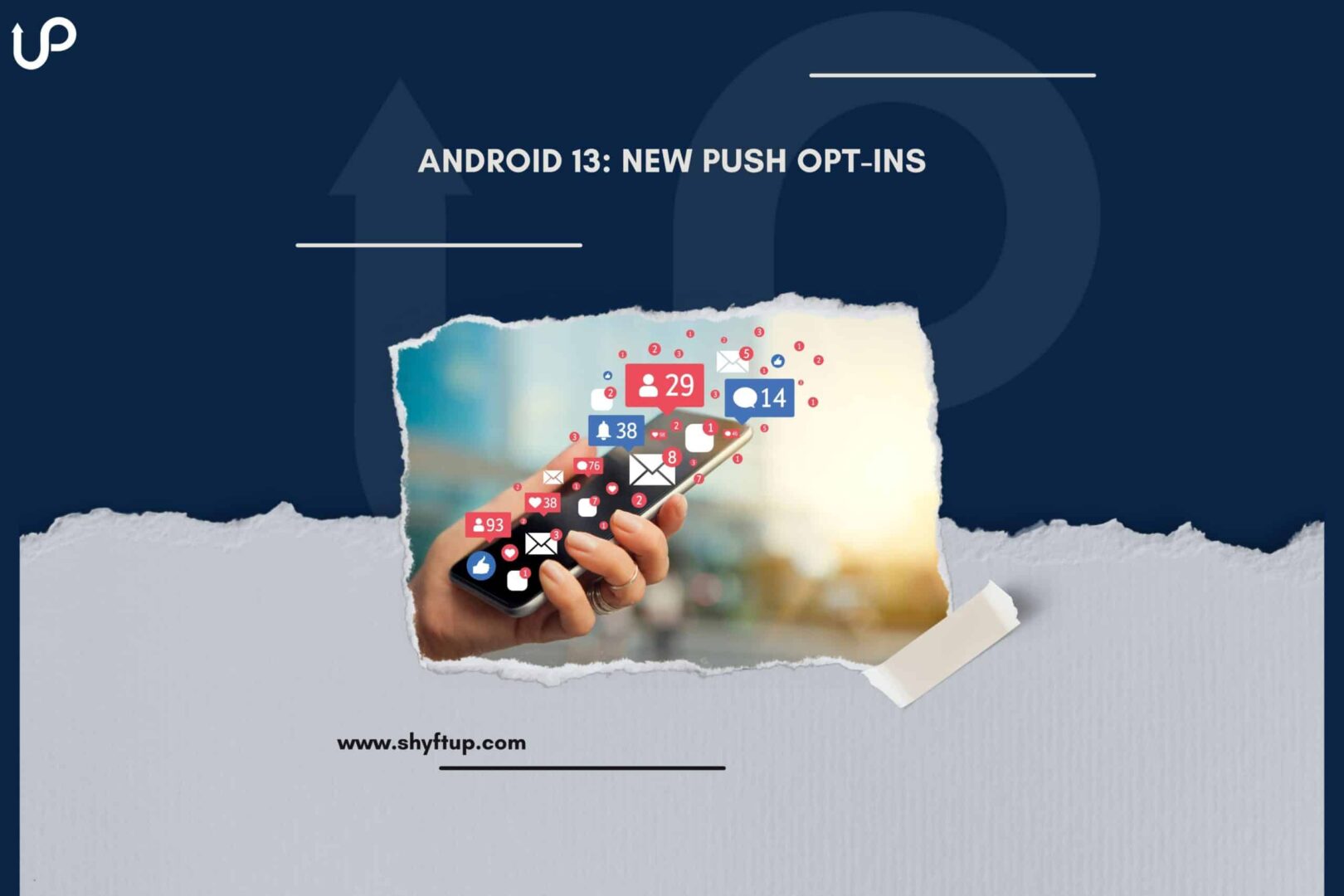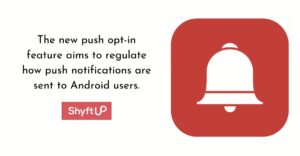
Android 13: New Push Opt-Ins
If there’s one thing we must expect from the Android OS, it is its updates. Last October 2021, Android 12 was released. Now, the Android 13, with the codename, “Tiramisu,” is expected to have its stable launch in August this year.
It has a lot of cool features that will surely make any smartphone more functional and impressive. However, there’s one important update of the Android 13 that should concern every app developer and marketer. This is the new push opt-in.
In this post, we are going to learn more about this push opt-in, how it works, and most importantly, what it means for app developers.
What are push notifications?
A push notification is a type of messaging system that allows apps to “push” notifications as a pop-up message on a mobile device. Users can receive push notifications whether they are using the app or not.
Image source: Unsplash
As you can imagine, push notifications are a great tool to grab people’s attention, send them updates, and remind them to use the app again.
Why did Google include push opt-ins on Android 13?
Google introduced push notifications in 2010. It is an amazing feature that helps app developers to direct their users back to their app.
However, as you can imagine, the use of push notifications can be noisy at times. It might be helpful to tell users about the latest updates, but if abused, push notifications can be overwhelming.
Because of how competitive the market is today, some apps may feel the pressure to send more and more notifications. This gives push notifications a bad rap.
Aside from that, Apple has already included push opt-ins in its operating system, which is a good move, especially for its users.
Google sees the sense of regulating push notifications. Thus, Google made the decision to turn off push notifications by default and let the user decide whether to enable them or not.
How do push opt-ins work?
Android 13 makes push notifications opt-in. However, how does it actually work?
Obviously, push notifications still have their important function even if they can sometimes be annoying. So, the aim of Google is not to remove it entirely, but to regulate its use.
Currently, before Android 13, users can choose not to get push notifications. However, by default, people automatically receive push notifications unless they manually turn them off.
The problem is that it is not that easy to turn off notifications. There are just so many steps involved.
So, if your phone runs on Android 13, the opposite would happen. You would need to manually turn on push notifications.
How will push opt-ins affect apps?
There are two ways that push opt-ins affect apps. It would depend on whether the app will be installed before Android 13 was released or if the app is already installed after Android 13 was released.
Apps installed before the Android 13 release
If your app is already installed before the new version is added, your app would still be able to send push notifications provided that the push notification is enabled prior to the release of Android 13.
In this scenario, you get temporary permission to send push notifications. This should be a good opportunity for you to wisely use your temporary permission.
This is how it may work:
- If the user hasn’t updated their Android OS version yet, you can still send push notifications until the user goes to the system permission setting and turn off the notification.
- If the user has updated their Android OS to version 13, you can still send push notifications until they open your app. However, once they open your app for the first time after Android 13 was installed, users would be asked for permission. If they choose to give you permission, then you can continue sending push notifications. If not, then you would lose this feature.
Apps installed after the Android 13 release
Once the mobile device is running Android 13 and your app is installed, you would need to ask for permission before you can send push notifications.
A system prompt would appear when the app is opened for the first time given you haven’t set when you want to get your permission.
If in case a user hasn’t updated their Android OS to version 13, push notifications will be disabled by default until the user would turn it on.
Will this affect Opt-In rates?
The answer is more likely yes. As we have seen with iOS, manually turning on push notifications decreased opt-in rates and this can also be the case with Android.
As you can imagine, when you give people the power to choose between opting out and opting in for push notifications, they would most likely use that power to opt-out.
Aside from that, a lot of users have grown tired of notifications. With people trying to decrease their internet consumption and screen time, they would be more selective as to which push notifications to allow.
Moreover, not all people realized the importance of push notifications. So, they might automatically just ignore the need for them and settle for a less noisy mobile device.
How to prepare for push opt-ins for Android apps
The new push opt-ins could either be a blessing or a curse for your app. Since it will affect all apps, those who can’t cope with the change would find it hard to stay on top of their game.
So, if you can take advantage of this new update, it’s a great opportunity for you to rise above the competition.
That’s why it’s best to know how you can prepare for these changes. We have gathered some of the most important tips you should remember:
Upgrade your app for Android 13
It’s inevitable. Android 13 is coming and it is something that every app developer should expect. For this reason, you need to take the necessary steps to make your app compatible with Android 13.
Thankfully, Google allows developers to try out Android 13 before its official release. This should help you learn exactly how the new OS version would affect your app and do the necessary adjustments.
Failure to upgrade your app could negatively affect your ability to reach users, monetize, and even retain existing users.
Improve the quality of your push notifications
Some users may just be still putting up with your push notifications simply because they don’t know how to turn it off or they just don’t want to be bothered with turning off your notifications.
If your users are already annoyed with your push notifications, they would most likely turn it off once they are presented with the option to easily turn notifications off.
Thus, you should check the type of push notifications that you are sending. At the end of the day, it’s not about the quantity, but the quality of your messages.
People don’t mind push notifications as long as they see their value. If you send users beneficial notifications, they would surely want to receive them continually.
Check your push notifications. See how you can further improve it so that once Android 13 is rolled out, they would still let you send notifications.
To quickly assess the type of notifications you send, here are a few questions to ask:
- How often do I send push notifications?
- If I were the user, would I be annoyed with the frequency and type of notifications I receive?
- Am I sending my notifications at the right time?
- Do my push notifications give value to my users?
- Can I make my notifications more personal and meaningful?
- Is the tone of my notifications acceptable to the expectations of the user?
Learn how to properly request permission
What’s great about Android 13 is that it will allow you to decide when to ask for push notification permission and in what situation. How you will approach your user and how you will ask for permission would make the difference between engaging your users and losing them.
So, timing is the key as well as the message you communicate with your user.
Here are a few things to remember:
- Think about the best time to send permission.
- Be sure to send your request after your users have already seen the value of your app.
- Explain to your users the importance of push notifications.
Discover how to win back users
If you missed your chance to obtain your user’s permission, it’s never too late. Don’t lose hope as you may still be able to convince them to receive push notifications.
While it can be tricky to reverse the decision of your user, there are a few things you can do.
For example, you can add in-app messages or even banners that remind users what they are missing when they don’t receive push notifications.
Be sure as well that you give your users irresistible reasons to keep on receiving push notifications. Some users may have fear of missing out (FOMO) and you can use this to your advantage.
Take advantage of Android 13
With every change comes new opportunities. While the new push opt-ins could potentially lower user engagement, it is not all bad news. You can always look at this change as a way to improve your overall app performance.
If done right, push opt-ins could help you foster a healthier relationship and connection with your users. It forces you to be more conscious about how to communicate with your users. In return, your users will become more loyal to you.
In summary, one of the updates that come with Android 13 is turning push notifications off by default. This can either work for or against your app. Thus, make sure that you plan ahead and know how you should approach your users in getting their permission.
If you are unsure what to do with the updates of Android 13 or you want extra help, get in touch with ShyftUp.
ShyftUp is a leading user acquisition agency that understands well how Google and Android work. ShyftUp helps prepare your app for current and future changes. Schedule a demo today to see how they can help your app succeed!
How do I change push notifications of an Android app?
Go to settings. Select “Apps.” Choose the specific app that you want to change. From there, go to “Permissions” where you can change push notifications.
What are the new updates of Android 13?
So far, what we know is that aside from push opt-ins, Android 13 comes with more customization options, auto-theming icons, different lock screen clock setups, an updated Now Playing widget, an improved QR scanner, and better native Bluetooth LE Audio, and others.
When will Android 13 be released?
Android 13 is expected to be released in August 2022. However, its developer previews have already been released in February. The Beta was released around April. Platform stability happened around June.
Why did Google include push opt-ins on Android 13?
How will push opt-ins affect apps?
Apps installed before the Android 13 release
Apps installed after the Android 13 release
Will this affect Opt-In rates?
How to prepare for push opt-ins for Android apps
Upgrade your app for Android 13
Improve the quality of your push notifications
Learn how to properly request permission

